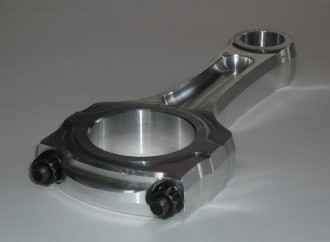
High performance Aluminum alloys for engine applications
Aluminum is extensively used for automotive chassis and engine applications. Properties like useful strength, low density, high thermal conductivity, excellent machining behavior and good corrosion resistance are the main reasons for using Aluminum. Future Hybrid and Electro automobiles need lightweight designing materials like Aluminum because Batteries are heavy.
Even used since more than 100 Years Aluminum has a high potential. With new production processes Aluminum alloys can pass a strength level of more than 1.000 MPa. A direct substitution of Steels seems to be achievable. New Aluminum-Composites with some unique features will introduce into the domain of Steel.
Most important for the use of these new Aluminum materials will be the question, how they could be introduced into existing processing lines.
Aluminum alloys for engines
More or less the same Aluminum cast alloys for engine applications are in use since decades. In the past years some application could be found for high performance Aluminum composites for cylinder liners or valve retainers.
For highly stressed Diesel engines heavy Cast-Iron alloys are preferred because of their strength. Current trend are smaller displacements and higher pressure of turbo chargers or compressors. This will additionally stress all engine parts. For the replacement of cast iron engine parts the new Aluminum alloys and Aluminum composites needs to be competitve.
Connecting Rods
Many trials have been made to introduce Aluminum Conrods into OEM engines but all failed. They are in use only for Drag Racing. Reasons are to low fatigue resistance, high CTE and low modulus. Especially the lack of fatigue resistance of up to 3x10^7 cycles is the major hurdle for the introduction. Most of the Aluminum alloys have not definite fatigue resistance like Steels.
However new Aluminum alloys and composites show significantly improved properties. Especially Aluminum composites show high fatigue strength, very high modulus and a CTE close to that of Steel. The fact that Aluminum composites show high compressive strength makes them even more attractive for Diesel and Turbo-charged engines. Aluminum Conrods needs slightly more space compared to Steel or Titanium Conrods because of lower strength. Also important is the design of the connection between the both Conrod parts. Today Steel Conrods usually have the threads in the upper Conrod part. An Aluminum Conrod with this design is very difficult to realize because of the higher notch sensitivity. It is better to use a traditional Bolt/Nut connection. Aluminum Conrods have also the advantage that they could slightly reduce Piston temperature because of the high thermal conductivity. This is very attractive for Diesel-and Turbocharged Pistons.
AMT has realized Aluminum Conrods fro Diesel and Gasoline engines. It must to bear in mind that Aluminum Conrods are lighter than Steel and even Titanium ones but the translating mass is not reduce with the same amount than the overall weight. This is because of the lower strength of Aluminum alloys. The stiffness of new Aluminum composite Conrods is higher than that of Steel because of their high specific modulus. Typical weight reduction is about 35-40% compared to 1.100 MPa Steel. New Aluminum composite Conrods could be also introduced in existing processing routes like Laser-cracking. Another feature is the possibility to avoid the use of a bushing because most of these new Aluminum-composites show excellent friction behavior and bearing strength.
Pistons
AMT participated in extensive developments of new Piston alloys. The aim was to find new piston alloys that could match the numerous requirements of automotive piston alloys. We have tried mechanically alloyed, melt-spun, liquid metal infiltration of ceramic performs, spray-forming and conventional wrought metallurgy processed Aluminum alloys.
Conventional Aluminum piston alloys have reached their high temperature strength limit especially for the use in Diesel-and Turbocharged engines. Complex cooling galleries and external cooling nozzles could extend increase their service temperature. But further improvement with traditional Aluminum alloys is not possible. For this reason in the past years piston manufacturers want to introduce Steel pistons. But these Steel pistons suffer from weight, high cost and corrosion problems. Their low thermal conductivity could led to Oil coking in the ring area. From advantage is the low CTE of Steel piston that matches that of Cast-Iron engine housings.
A solution for high performance pistons is the DSC-Technology for DSC-Aluminum or even DSC-Magnesium pistons. See also DSC-Materials information in menu item Aluminum high temperature.
Engine housings, reinforced with the DSC-Technology
Engine housing made via high pressure die castings could be reinforced locally with ceramic performs. From interest are areas like the cylinder liner and bearings of the housing and the bearing cap/bedplate.
Properties
- Compared to the unreinforced matrix alloy, strength is significantly increased because of dispersion strengthening. Elevated temperature, 150°C, strength is comparable to Grey-Cast-Iron. This allows a 1:1 material substitution within the reinforced areas.
- Potential service temperatures are increased to above 400°C. Properties could be widely influenced by the choice of the matrix alloy.
- Infiltrated areas show good sliding, friction behavior and wear resistance, important for cylinder liners.
- Fatigue resistance is also significantly increased, important for the bearing area.
- DSC-Al shows low CTE and high stiffness. These are very important features for cylinder liners.
- Because of nanometer sized Alumina particles the machining behavior is much better compared to other Aluminum composites.
· Because of the large increase in strength it is for many applications not necessary to use an expensive matrix alloy, e. g. Al-Si10.


